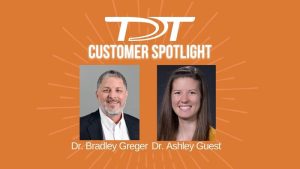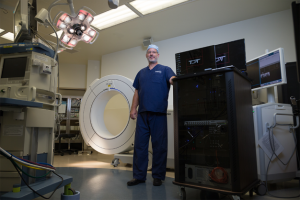Customer Spotlight: Drs. Bradley Greger & Ashley Guest
December 21, 2022

Dr Bradley Greger and MD/PhD student Dr Ashley Guest are members of the Neural Engineering Laboratory at the University of Arizona College of Medicine. Their lab focuses on understanding the mechanisms underlying neural pathologies and developing treatments for these pathologies.
Bradley Greger is an Associate Professor at the School of Biological and Health Systems Engineering. He is a neuroscientist and neural engineer, whose work focuses on restoring movement and sensory function through neural prosthetics and utilizing neural interface technology to increase our understanding of human neural function.
Ashley Guest is an MD/PHD student with a prospective graduation date of May 2024. She earned her PhD in 2022 with a major in Clinical Translational Sciences and research in deep brain stimulation in movement disorders. She is interested in the clinical field of Child Neurology.
| In a recent publication (see TDT’s Publication Spotlight), Dr. Greger and Dr. Guest performed in vivo human studies that utilized Deep Brain Stimulation (DBS) – a technique used as a therapeutic tool to treat motor disabilities caused by Parkinson’s Disease – to analyze the resulting electromagnetic field (EMF) that is generated within the neural tissue. This approach provided valuable information on how the EMF strength changed with distance from the site of DBS and helped elucidate the functional connectivity between the subcortical and cortical neural structures of the movement pathway. Here, we dive deeper into the inspiration that led these scientists to pursue these studies. |
What brought you to neuroscience and medicine?
Guest: In undergrad, I majored in neuroscience. It was my initial interest in anything having to do with science in general and medicine specifically. I loved my major. I also got involved in research at the time and really like the perspective of asking questions and using the scientific method to answer questions. I loved all of that. My volunteering and shadowing experiences made me want a component to my career that included working with people and their medical problems, so that’s how I landed on the dual degree route – to combine the two training perspectives, medical and scientific.
I think the perspectives from both the medical side of things and the scientific side of things give me a unique way of thinking. When I’m thinking the way of one world and I’m in the other, it just rounds out my ability to ask questions, either with trying to figure out what’s wrong with the patient, or to ask a broader research question that applies to a group. That gets at more of a scientific approach to questions.
What is an example where you used your scientific training to look at a patient and try to understand the patient better?
Guest: I think a lot of my clinical reasoning is driven by hypothesis testing, which came from my scientific background. This helps with diagnosing a patient. Much of academic training is about building a differential diagnosis. In building my differential and asking what evidence is there for this one and not that one, my approach is to test if the diagnosis is correct by using physical exams or by ordering specific lab tests to prove or disprove the diagnosis. I find myself more amenable to digging into the primary literature to find the reasons behind why I use a certain drug or therapy.
What is an example of where you used your clinical training to look at a research-related question to understand it better?
Guest: When I’ve attended conferences and when we’ve had joint lab meetings and I’m amongst research scientists who ask good and interesting questions, which are follow-up questions to their research. The questions are often not driven by what is important to the patient and will make a difference in their life. Not all scientists are as forward thinking as Bradley about what occurs in humans. For example, there’s a Deep Brain Stimulation that uses rodent and NHP animals. These model organisms differ from humans. The DBS electrode, the size of the electrode, the spatial field of the stimulation, are all different in these models. They use microelectrodes in these animals that don’t translate easily to the clinical electrodes and what is done in DBS. Researchers often want to understand what their specific findings mean. Their follow-up research is focused on that path and not always with a clinical perspective of whether this will improve the course of the disease or improve the patient’s experience.
What research is your lab currently performing?
 Greger: My lab utilizes in-vivo microelectrode arrays to study neural function and pathology. We are acutely and chronically recording action potentials and local field potentials in both the central and peripheral nervous systems. Using this technology, we have decoded spoken words and finger movements from neural signals recorded on microelectrode arrays implanted over language and motor areas of human cerebral cortex and studied the pathophysiology of seizure disorders.
Greger: My lab utilizes in-vivo microelectrode arrays to study neural function and pathology. We are acutely and chronically recording action potentials and local field potentials in both the central and peripheral nervous systems. Using this technology, we have decoded spoken words and finger movements from neural signals recorded on microelectrode arrays implanted over language and motor areas of human cerebral cortex and studied the pathophysiology of seizure disorders.
Using micro-stimulation of the primary visual cortex, we have demonstrated the viability of using micro-electrodes as the basis for a visual prosthesis for restoring limited vision in the profoundly blind. We have decoded finger movements and provided sensory feedback using microelectrode arrays implanted in the residual peripheral nerves of patients with an amputation. Currenytly, my lab is collaborating with neurologists and neurosurgeons at the Barrow Neurological Institute to study and improve treatments for Parkinson’s Diseasea. We are using arrays of microelectrodes to examine the neural dynamics in the cortico-basal ganglia network during Deep Brain Stimulation.
Research Paper Highlight
What is the most unique property of the paper?
Guest: One of the unique perspectives is the spatial scale. We look at individual neurons in the subthalamic nucleus and we also use what we call a micro-ECoG grid on the cortex. It has a smaller electrode diameter and a small resolution spatial scale that is typically used in electrocorticography. That’s the most unique part of our paper, that we’re really examining on either a single neuron or a local field potential scale. A lot of work that’s been done in DBS is more towards the macro scale.
The thing that’s most unique about our paper is we’re showing a correlation between the action potentials in the subthalamic nucleus with cortical responses at the surface, which is a long way away. We did spike-triggered averaging. We take each action potential and then look at the LFPs. The action potentials in the subthalamic nucleus were strongly correlated with the local field potentials in the subthalamic nucleus. And they were also correlated with the local field potentials recorded on the micro-ECoG grid in the premotor cortex. So there’s some sort of cool oscillatory connection between the subthalamic nucleus and the subcortical structure in the motor cortex.
What is your next step?
Guest: Looking at awake patients and incorporating DBS. For the DBS stimulation, we already collected that data for anesthetized patients and Bradley is analyzing it. We looked at different stimulation frequencies and the effect of the signal in the cortex for the anesthetized patients.
For the awake studies, the micro-ECoGs will be placed for a month instead of just during the surgery. This is for pain patients, who are part of a clinical care study. The regions we will target are the periaqueductal gray, the thalamus, and the ventral tegmental area, a reward area in many animals, to mitigate the pain. Where the pain is located guides the placement of the target. For example, targeting the thalamus to mitigate pain in the trigeminal area. The targeting is very nuanced. For this patient we targeted two areas, and one was better than the other. Where you place the micro-grid will determine the coupling to the neural stimulation and action potentials. For example, a target that links to the sensory area to look at global vs local differences.
What is the advantage of doing the surgery with anesthetized patients?
Guest: Normally, patients are awake, but at the Barrow Clinic under Dr. Ponce, the neurosurgeon, he pioneered this technique of doing it while the patients stay asleep the whole time, and not too shockingly, patients prefer that, and he does about twice the caseload of most neurosurgeons who do DBS.
What did TDT do to make this research possible?
Guest: TDT helped by providing a system for high bandwidth neural recordings. We are using the Medtronic Percept system for long-term low bandwidth neural recordings along with the short-term neural recording high bandwidth. The new experiments will allow us to record high bandwidth data for a month.
[ back to top ]
